Harvard Natural Sciences Lecture Demonstrations
1 Oxford St Cambridge MA 02138 Science Center B-08A (617) 495-5824
enter search criteria into the search box
Key to Catalog Listings
Size: from small [S] (benchtop) to extra large [XL] (most of the hall)
Setup Time: <10 min [t], 10-15 min [t+], >15 min [t++] /span>
Rating: from good [★] to wow! [★★★★] or not rated [—]
Copyright © 2024 The President and Fellows of Harvard College | Accessibility | Digital Accessibility | Report Copyright Infringement

